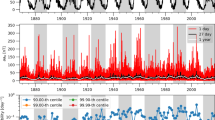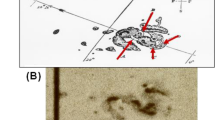Abstract
The orbital evolution of the near-Earth asteroid (NEA) 30825 1990 TG1 has been studied by numerical integration of the equations of its motion over the 100 000-year time interval with allowance for perturbations from eight major planets and Pluto, and the variations in its osculating orbit over this time interval were determined. The numerical integrations were performed using two methods: the Bulirsch-Stoer method and the Everhart method. The comparative analysis of the two resulting orbital evolutions of motion is presented for the time interval examined. The evolution of the asteroid motion is qualitatively the same for both variants, but the rate of evolution of the orbital elements is different. Our research confirms the known fact that the application of different integrators to the study of the long-term evolution of the NEA orbit may lead to different evolution tracks.
Similar content being viewed by others
References
Gladman, B., Michel, P., and Froeschle, C., The Near-Earth Object Population, Icarus, 2000, vol. 146, pp. 176–189.
Guillens, S.A., Martins, R.V., and Gomes, R.S., A Global Study of the 3:1 Resonance Neighborhood: a Search for Unstable Asteroids, Astron. J., 2002, vol. 124, pp. 2322–2331.
Ipatov, S.I., Migration of Asteroids from the 3:1 and 5:2 Resonances with Jupiter to the Earth, IAA Trans. Celest. Mech., 2002, vol. 8, pp. 88–89.
Michel, P., Froeschle, Ch., and Farinella, P., Dynamical Evolution of NEAS: Close Encounters, Secular Perturbations and Resonances, Earth, Moon, and Planets, 1996, vol. 72, nos. 1–3, p. 151.
Morbidelli, A., Bottke, W.F., and Froeschle, Ch., et al., Origin and Evolution of Near-Earth Objects, Asteroids III, Bottke, W.F., Cellino, A., Paolicchi, P., and Binzel, R.P., Eds., Tucson: Univ. Arizona Press, 2003, p. 409.
Shor, V.A., Ed., Efemeridy malykh planet na 2005 god (Ephemerides of Minor Planets for 2005), St. Petersburg: Inst. Prikl. Astron. Ross. Akad. Nauk, 2004.
Timoshkova, E.I., The Orbital Evolution of Near-Earth Asteroids in the 3:1 Mean Motion Resonance, Order and Chaos in Stellar and Planetary Systems, Byrd, G., Kholshevnikov, K., Mullari, A., et al., Eds., 2004, vol. 316, pp. 118–121.
Timoshkova, E.I., Statistical Analysis of Orbital Evolution of the Group of Near-Earth Asteroids in the 3:1 Resonance with Jupiter, Materialy konf. “Asteroidno-kometnaya opasnost’-2005” (Proc. of the Conf. “Asteroid-Cometary Hagard 2005), St. Petersburg, 2005, pp. 316–319.
Vinogradova, T.A., Zheleznov, N.B., Kuznetsov, V.B., et al., Catalogue of Potentially Dangerous Asteroids and Comets, Tr. Inst. Prikl. Astron. Ross. Akad. Nauk, 2003, no. 9, pp. 7–132.
Wisdom, J., Chaotic Behavior and Origin of the 3/1 Kirkwood Gap, Icarus, 1983, vol. 56, no. 1, pp. 51–74.
Author information
Authors and Affiliations
Additional information
Original Russian Text © E.I. Timoshkova, 2008, published in Astronomicheskii Vestnik, 2008, Vol. 42, No. 1, pp. 30–36.
Rights and permissions
About this article
Cite this article
Timoshkova, E.I. The orbital evolution of NEA 30825 1900 TG1. Sol Syst Res 42, 28–34 (2008). https://doi.org/10.1134/S0038094608010048
Received:
Published:
Issue Date:
DOI: https://doi.org/10.1134/S0038094608010048




